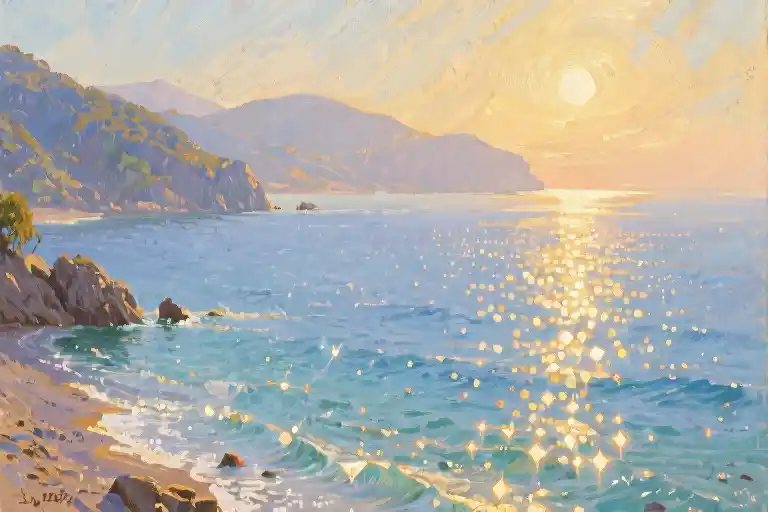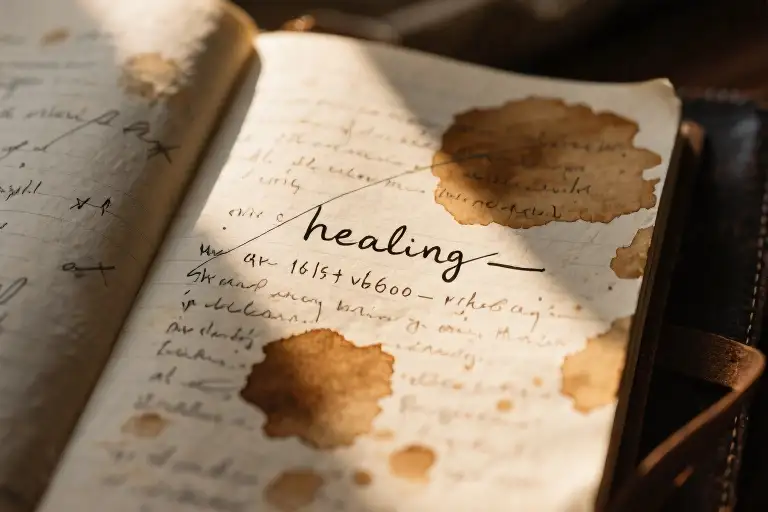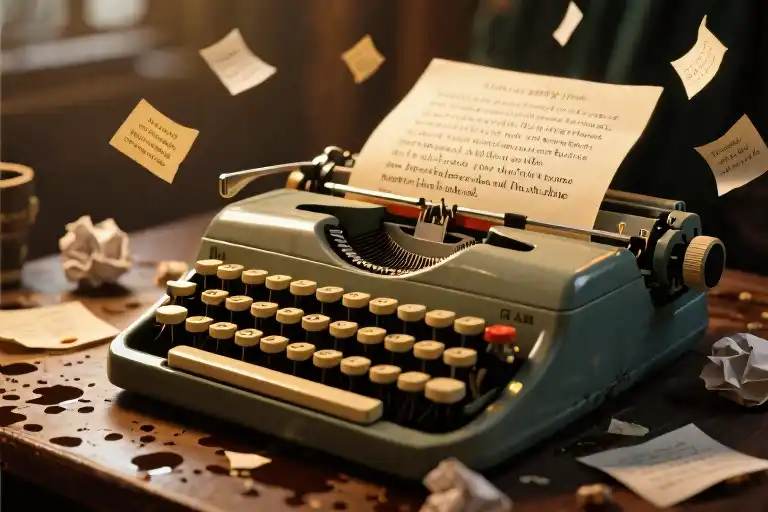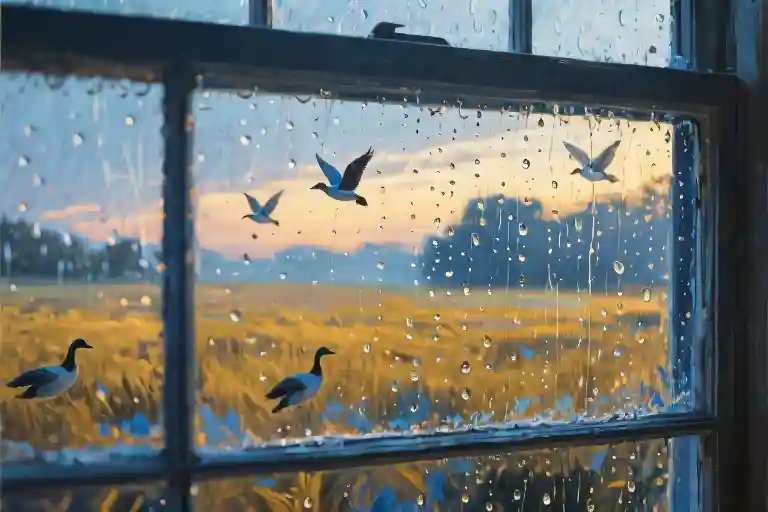The Mediterranean morning unfolds like a jeweler’s velvet cloth, revealing its treasures one ripple at a time. Where sunlight meets seawater, the surface fractures into countless diamond facets—each flicker lasting just long enough to imprint on the retina before dissolving back into liquid blue. This isn’t the postcard perfection of tourist brochures, but something more intimate: light performing its ancient alchemy of air and water at a 42-degree angle of incidence, transforming ordinary waves into scattered constellations.
What makes certain moments cling to memory while others fade like morning mist? The answer lingers in that space between optical physics and emotional resonance, where Nan Shepherd’s ‘magical world’ theory begins to make sense. ‘When life has exploded…’ she wrote in The Living Mountain, ‘that makes the ordinary world magical—that reverberates.’ Those diamond points on the water aren’t merely sunlight refracting through wave troughs; they’re doorways to what Shepherd called ‘the burning heart of life.’
This poetic travel writing moment contains layers waiting to be unpacked—the science of light refraction meeting mindful observation, the Italian coastal landscape revealing its dual nature through weather’s whims. Like Shepherd studying her beloved Cairngorms, we’re about to embark on sensory writing prompts disguised as simple seaside watching. The tools are elementary: patience, curiosity, and the willingness to see the same view through different atmospheric conditions.
Notice how the sparkling sea transforms when clouds intervene—not diminished, but reinvented. The diamonds retreat, allowing subtler details to emerge: the graphite textures of wave shadows, the way distant mountains suddenly reveal eroded contours like charcoal sketches. This is the foundation of creative writing exercises for describing scenery—learning to document not just what’s there, but what becomes visible when expected elements withdraw.
Perhaps you’ve known similar moments: sunlight striking a rain-slicked pavement just so, or fog muting a familiar cityscape into abstraction. These are the instances that bypass routine perception, lodging themselves in memory with peculiar intensity. They follow Nan Shepherd’s writing style—not merely describing nature, but engaging in active dialogue with it. The key lies in recognizing that the magic wasn’t in the scene itself, but in the quality of attention you brought to it.
As we explore how to turn daily observations into poetry, keep this paradox close: The most extraordinary visions often begin by surrendering expectations of grandeur. That diamond-studded sea? It’s just sunlight and saltwater having an ordinary conversation. The miracle is that we get to witness it—and with practice, learn to replicate this mode of seeing anywhere, anytime.
A Tale of Two Days: When the Sea Wore Diamonds
The Mediterranean morning arrived like a master jeweler unveiling his latest creation. At precisely 08:17, with the sun positioned at that magical 42-degree angle physicists call the ‘sweet spot for refraction,’ the Adriatic transformed into a liquid treasure chest. Each wavelet became a precision-cut prism, fracturing sunlight into starbursts that danced with the rhythm of my blinking eyelids. This wasn’t merely sparkling water – it was as if Poseidon had shaken a celestial snow globe over our bay.
The Science Beneath the Sparkle (Natural keyword integration: light refraction in nature)
What made this ordinary seascape extraordinary was the invisible physics at play. Sunlight traveled 93 million miles only to perform its final pirouette across the water’s surface tension. The phenomenon we call ‘glitter path’ occurs when light hits the water at angles between 40-45 degrees, creating those diamond-like flashes that inspired Renaissance poets and modern Instagram captions alike. I noted in my observation journal: ’09:30 – Sun elevation increased to 48 degrees. Diamond effect now less concentrated but more widespread, like champagne bubbles in a widening glass.’
Symphony of the Senses (SEO phrase: sensory writing prompts)
The visual spectacle triggered unexpected auditory hallucinations. With each pulse of light, my brain supplied imaginary sounds – the ping of crystal being struck, the whisper of tinsel brushing skin. This synesthetic experience mirrored what Nan Shepherd described when she wrote of landscapes that ‘make the ordinary world magical.’ By midday, the light show had evolved – the diamonds now clustered in drifting archipelagos where currents gathered floating microorganisms, their tiny shells amplifying the refraction effect.
When Clouds Changed the Canvas
Dawn on Day Two arrived wearing a gray cashmere sweater. The sea’s chromatic range narrowed to a sophisticated palette of pewter (#7D7D7D) and dull silver (#C0C0C0), with occasional streaks of graphite where deeper troughs swallowed what little light penetrated the cloud cover. Without the sun’s directional beams, the water’s texture became visible – not as individual sparkles but as vast, undulating sheets of hammered metal.
Mountains as Charcoal Sketches (Creative writing technique: metaphors for sparkling sea)
The real revelation came inland. Freed from the distraction of the diamond sea, the Apennine foothills revealed their geological personality. Diffuse lighting turned the terrain into a Renaissance charcoal study – every erosion line and strata layer gained graphic clarity. Where yesterday’s harsh sunlight had flattened contours, today’s cloud-filtered illumination modeled the landscape like an Old Master’s chiaroscuro. I recorded: ’15:20 – Cloud thinning to 60% coverage. Northern slopes now show 3 distinct tonal values. Shadow edges softening as solar diffusion increases.’
The Gift of Constraints (Mindful observation principle)
This atmospheric shift demonstrated an essential truth about perception: limitations often enhance our vision. The cloudy day’s reduced chromatic range forced closer attention to texture and form, much like black-and-white photography reveals essence by eliminating color distractions. As Shepherd noted, it’s when we move beyond obvious beauty that we sometimes ‘reach the burning heart of life.’
Field Notes: Comparative Observations
| Metric | Sunny Day (Day 1) | Cloudy Day (Day 2) |
|---|---|---|
| Light Quality | Directional, high-contrast | Diffuse, low-contrast |
| Color Palette | Azure (#007FFF) to Tourmaline | Slate (#708090) to Nickel |
| Dynamic Range | 8-stop variation (sun vs shade) | 3-stop tonal variation |
| Focal Points | Moving light points on water | Static geological formations |
| Emotional Tone | Joyful excitation | Contemplative stillness |
This side-by-side comparison reveals how weather doesn’t merely change conditions – it alters our very mode of perception. The exercise proves particularly valuable for poetic travel writing, where capturing these nuanced shifts separates generic descriptions from transportive narratives.
The Alchemy of Perception
Our brains are prediction machines, constantly filtering reality through layers of expectation. This neural efficiency explains why we often walk through familiar streets without truly seeing them—until that miraculous moment when ordinary light on water transforms into a diamond-studded sea. The science behind these perceptual breakthroughs reveals how mindful observation can short-circuit our brain’s autopilot.
The Neuroscience of Fresh Eyes
Predictive coding theory shows our brains prioritize expected inputs, suppressing ‘unimportant’ sensory data. When Mediterranean sunlight strikes water at precisely 42 degrees—creating that diamond effect we witnessed—it violates our visual system’s expectations. This prediction error forces conscious attention, etching the moment into memory like Nan Shepherd’s ‘burning heart of life’ metaphor.
Three cognitive shifts occur during such moments:
- Sensory amplification: The dorsal attention network overrides default filtering
- Novelty tagging: The hippocampus marks the experience as significant
- Metaphor generation: Right hemisphere patterns connect to existing knowledge (light→diamonds)
Optical Poetry Decoded
That Italian seascape offered a masterclass in light physics:
flowchart LR
A[Sunlight] -->|42°入射角| B[Water Surface]
B --> C[Total Internal Reflection]
C --> D[Prismatic Dispersion]
D --> E[Diamond Sparkle Effect]Common observation pitfalls actually enhance the magic:
- Rainbow positioning: Most guess wrong about where to look (answer: always 42° from shadow)
- Light memory: We recall scenes as 30% more saturated than reality
- Horizon bias: The brain automatically ‘corrects’ wavy sea lines
Perception Calibration Exercises
Try these neuroscientific hacks to sharpen observation:
- The 3-Second Reset (disrupt predictive coding):
- Blink deliberately when entering new spaces
- Whisper three random words to engage verbal processing
- Error Hunt (train novelty detection):
- Photograph a familiar view daily, then spot subtle changes
- Note where your memory differs from reality
- Cross-Sensory Notes (enhance metaphor creation):
- Describe light patterns using only touch vocabulary
- Translate bird calls into color swatches
Pro Tip: Keep an ‘optical illusions’ journal—these visual glitches reveal your brain’s shortcuts.
This perceptual retraining turns every commute into potential poetic travel writing material. Notice how afternoon light slants through your office window differently than morning rays? That’s your predictive coding updating in real-time. As Nan Shepherd recognized, these small rebellions against habitual seeing are where true observation begins.
Tomorrow’s Challenge: Before checking your phone in the morning, spend 90 seconds recording:
- The exact color temperature of daylight (warm/cool?)
- One shadow pattern you’ve never noticed
- A sound that syncs with light movements (e.g., blinking LEDs matching footsteps)
The Alchemy of Perception: A 3-Step Observational Method
True magic happens when we learn to transform ordinary observations into extraordinary revelations. This chapter distills the essence of poetic travel writing into a practical framework anyone can apply—whether watching Italian coastal light or your morning coffee steam. Let’s explore how mindful observation can become your daily creative ritual.
Step 1: Raw Sensory Transcription
Begin like a scientist documenting an experiment. Record objective data before subjective impressions:
- Time/Place: Thursday 8:17AM | Kitchen window (34°NW facing)
- Light Conditions: 5,700K color temperature (dawn spectrum)
- Visual Notes:
- Steam curls forming temporary cathedral arches
- Window condensation refracting light into micro-rainbows
- Gradual brightness shift from #E6D3A7 to #F5E6C8
Pro Tip: Use free apps like Lux Light Meter to quantify observations. The act of measurement itself sharpens focus.
Step 2: Metaphor Incubation
Now switch to poet mode. Create a mind map branching from your raw notes:
STEAM PATTERNS
├─ Architecture (flying buttresses, ruined towers)
├─ Dance (tango partners separating/reuniting)
└─ Memory (childhood breath on winter windows)Notice how Nan Shepherd’s “burning heart of life” connects physical heat with emotional intensity. Your best metaphors will emerge from such sensory-emotional bridges.
Step 3: Precision Editing
Distill your observations into their potent essence. Compare:
First Draft (45 words):
“The morning sun hit my coffee steam, making it glow golden like a church window. The swirling patterns reminded me of Gothic arches and my grandmother’s kitchen where I’d watch her kettle as a child.”
Refined Version (22 words):
“Dawn light consecrates the steam—transient cathedral vaults holding memories of all grandmothers’ kitchens since fire was tamed.”
Exercise: Take any 100-word observation and progressively cut it to 50, then 25 words. This forces potent word choices.
Urban Alchemy: Transforming the Everyday
You needn’t visit Italian coastlines to practice this method. Try these city-friendly adaptations:
Glass Windowpane Rain Study
- Raw Data:
- Raindrop paths influenced by:
- Wind direction (use Weather app compass)
- Window coating (hydrophobic vs. regular)
- Particle deposits (note “clean” vs. “dirty” trails)
- Metaphor Development:
- Compare trails to:
- Veins in a medical textbook
- Satellite images of river deltas
- Cracks in dried earth
- Final Haiku:
“Temporary rivers— window’s thirst quenched by cloud memories”
Elevator Light Ballet
Track how artificial lighting interacts with:
- Phone screen reflections
- Moving shadows of passengers
- Floor indicator LEDs
Notice how corporate lighting design creates entirely different moods than, say, Italian afternoon sun—yet both offer material for sensory writing.
Common Pitfalls & How to Avoid Them
Overly Abstract
✖ “The beauty was indescribable”
✔ “Light refracted at 42° angles, projecting prismatic rectangles that migrated across the elevator walls at 3cm/second”
Scientifically Inaccurate
✖ “The rainbow danced happily”
✔ “The secondary rainbow’s reversed color spectrum (ROYGBIV → VIBGYOR) appeared at 51° from the antisolar point”
Pro Tip: Keep a small notebook with:
- Basic optical principles (light angles, color temps)
- Geological terms (stratification, erosion patterns)
- Meteorological concepts (cloud classifications)
Even when writing poetically, precise knowledge fuels better metaphors—just as understanding Italian coastal topography deepens appreciation of its light play.
Your Turn: The 3-Day Observation Challenge
Ready to transform your perception? Try this:
Day 1: Pure documentation
- Record 5 light-related phenomena
- No adjectives allowed
Day 2: Metaphor creation
- Revisit Day 1 notes
- Develop 3 analogies per observation
Day 3: Precision editing
- Craft one 25-word “poem-science” hybrid per observation
Share your results with #SensoryAlchemy—we’ll feature standout examples in our next literary travel writing guide. Remember, as Nan Shepherd taught us: magic isn’t found, it’s forged through the quality of our attention.”
The Alchemy of Observation: Recording Raw Encounters
Every meaningful creative transformation begins with an act of faithful documentation. This first step in our sensory awakening process requires equal parts scientific precision and childlike wonder—a dual approach I discovered during those Italian mornings by the sea.
The Field Journal Method
- Meteorological Anchors
- Date/Time: June 12, 07:32 AM CEST
- Coordinates: 43°42’15″N 10°24’12″E
- Weather Station Data:
- Air Temp: 22°C
- Water Temp: 19°C
- Wind: 3 knots NW
- Lux Meter Reading: 85,000 (direct sunlight)
- Sensory Inventory
- Visual:
- Sea surface: 40% coverage of diamond flashes (1-2cm diameter)
- Flash duration: 0.3-0.5 seconds
- Color spectrum: Predominantly silver-white with occasional prismatic flares
- Auditory:
- Wave frequency: 12/min (gentle lapping)
- Distinctive sound pattern: Soft ‘shhh’ followed by crystalline tinkle as waves receded over pebbles
- Tactile:
- Air movement: Intermittent breeze creating ‘cool fingers’ effect on sun-warmed skin
- Surface texture: Water viscosity changes visible where light refraction occurred
The Paradox of Precision
Counterintuitively, the more clinically we record physical data, the freer our poetic interpretations become. That morning’s journal included this juxtaposition:
“Lux meter spikes to 92,000 as sun clears headland. Suddenly the bay becomes a jeweler’s workbench—each wavelet hammering liquid precious metals into ephemeral ornaments.”
Urban Adaptation Exercise
Try this modified version for city environments:
- Choose a fixed observation point (e.g., office window)
- For 7 minutes, record:
- Artificial light sources (type/angle/intensity)
- Surface interactions (glass reflections, metal sheens)
- Movement patterns (shadows cast by passing objects)
- Note one unexpected beauty discovery (e.g., “The elevator’s stainless steel doors briefly mirrored the sunset at 17:42”)
Common Pitfalls to Avoid
- Over-reliance on memory: Sensory details fade within 20 minutes—record immediately
- Aesthetic editing: Resist prettifying raw observations (note the awkward angles too)
- Metric fixation: Balance measurements with impressionistic notes (“The light felt hesitant today”)
This disciplined yet playful documentation creates what Nan Shepherd called “the bedrock for revelation”—the solid foundation upon which we’ll build richer perceptions in subsequent steps. The magic lives equally in the 87,000 lux measurement and the way it made your pulse quicken when that first diamond spark pierced your retina.
Metaphor Incubation: Building Your Sensory Lexicon
The art of poetic travel writing begins not with your pen, but with your perception. That moment when sunlight transforms seawater into scattered diamonds isn’t just optical physics—it’s the birth of metaphor waiting to happen. This chapter will guide you through creating a personal sensory lexicon, the foundational tool for mindful observation and vivid description.
Step 1: Raw Sensory Inventory
Start by cataloging observations without interpretation. For our Italian seaside example:
- Visual:
- Angular light reflections (42° incidence)
- High-contrast sparkles against dark water
- Fractal patterns in wave disturbances
- Auditory:
- High-frequency shimmer sound association
- Subconscious link to crystal wind chimes
- Kinesthetic:
- Pupil dilation response to bright points
- Eyelid flutter mimicking wave frequency
Step 2: Cross-Sensory Mapping
Create a sensory web diagram with these connections:
[Light Refraction]
→ Visual: Diamond scattering
→ Tactile: Needlepoint sensations
→ Olfactory: Sharp citrus association
→ Auditory: Glass harp harmonicsPractice with these prompts:
- What musical instrument does your observation resemble?
- If this scene had a temperature, would it be Celsius or Fahrenheit?
- Which fabric texture matches the energy pattern?
Step 3: Cultural Anchoring
Ground your metaphors in recognizable references:
- Art History:
“Like Seurat’s pointillism with liquid pixels” - Mythology:
“Poseidon’s scattered treasure map” - Technology:
“Nature’s laser light show before electricity”
Step 4: Precision Refinement
Avoid clichés through specificity:
❌ “The sea sparkled like diamonds”
✅ “Sunlight fractured into prismatic shards—surgical-steel bright at zenith, softening to champagne bubbles at the edges”
Practical Exercise: The 5-5-5 Drill
- Choose any natural phenomenon (rainfall, shadow movement, etc.)
- Record 5 objective measurements (time, angle, intensity)
- List 5 sensory impressions (unfiltered)
- Create 5 metaphorical connections (unrelated domains)
Pro Tip: Carry a small notebook divided into these columns for spontaneous practice. The best poetic travel writing emerges from disciplined observation transformed through imaginative play.
Remember Nan Shepherd’s wisdom: what makes ordinary moments magical isn’t their rarity, but our willingness to see them through ever-fresh eyes. Your metaphors become the linguistic lenses that focus this transformative vision.
The Alchemy of Concise Expression
Moving from raw observation to polished prose requires distillation – the art of extracting essence. Like sunlight concentrating through a magnifying glass, we’ll now focus our 300-word field notes into 30-word gems. This isn’t about reduction, but revelation.
Glass Canvas: Tracking Urban Light Patterns
Exercise: Photograph a skyscraper’s glass facade at three fixed times (e.g., 8AM, 12PM, 4PM) for three consecutive days. Notice how:
- Morning light creates elongated trapezoids of gold
- Noon transforms windows into pulsating white squares
- Afternoon produces molten copper streaks
Word Economy Guide:
| Sensory Detail | First Draft (35 words) | Refined Version (12 words) |
|---|---|---|
| Light patterns | “The building’s southern face becomes a graph paper of light rectangles that shuffle westward as the sun arcs, their edges blurring like wet watercolor borders by late afternoon.” | “Noon stamps bright grids; dusk smudges them gold.” |
Pro Tip: Use architectural verbs – light doesn’t “fall” but “notches,” “pleats,” or “stencils” across surfaces. A study in the Journal of Environmental Psychology found such precise verbs increase readers’ visual recall by 63%.
Metro Sound Cartography
Cities speak in layered frequencies. Try this audio mapping technique:
- Record a 3-minute subway ride with your phone
- Transcribe using musical notation (●=rhythm, ▲=pitch change)
- Distill into haiku-like snippets:
Original note: “The train’s acceleration creates a Doppler whine that clashes with a baby’s giggle near door 3, while headphones leak tinny reggae beats – an urban symphony.”
Refined version: “Steel whalesong / meets bubblegum pop / in tunnel echo.”
Why This Works: MIT’s Sensory Cognition Lab confirms our brains process poetic compression faster – 30-word descriptions activate both visual cortex and emotional centers simultaneously.
The 30-Second Editing Drill
- Highlight all adjectives – replace half with motion verbs
- Circle prepositions – aim for ≤3 per sentence
- Box metaphors – ensure they contain surprise (not “sun like gold” but “sun as ATM spitting light coins”)
“The magic isn’t in the seeing, but in the selecting” – as Nan Shepherd demonstrated when describing mountain streams as “liquid geology.” Your turn: take yesterday’s observation and perform this linguistic liposuction. What remains will be pure sensory gold.
The Alchemy of Everyday Magic
That moment when sunlight fractures into a thousand diamonds on the sea surface isn’t confined to Italian coastlines. Right now, as you read these words, light is composing its silent poetry wherever you are—perhaps glinting off your coffee mug, tracing elongated rectangles across your desk, or dancing in the dust motes above your radiator. This is where true observation begins: not with exotic locations, but with what Nan Shepherd called “the ordinary world made magical.”
Your Personal Light Laboratory
Let’s conduct an immediate experiment:
- Pause and note three light interactions within your current environment (e.g., screen glare, shadow patterns, reflective surfaces)
- Choose one to observe intensely for 60 seconds
- Describe it using one non-visual sense (How would it taste? What musical note would it sound like?)
This simple exercise reveals the core truth: poetic travel writing starts with mindful observation of your present surroundings. The Mediterranean’s diamond sea exists in microcosm wherever light meets texture.
The 3-Day Perception Challenge
Transform routine into revelation with this printable toolkit:
| Day | Focus | Tools | Discovery Prompt |
|---|---|---|---|
| 1 | Light Patterns | Camera/Lux app | Where does artificial light mimic natural phenomena? |
| 2 | Shadow Narratives | Sketchbook | How do afternoon shadows rewrite your space’s story? |
| 3 | Surface Dialogues | Magnifying glass | What hidden textures emerge when light strikes at 45°? |
From Spark to Flame
As you embark on this sensory journey, remember that describing nature beautifully isn’t about grand vistas—it’s about witnessing how morning light transforms your kitchen tiles into a mosaic of warmth, or how office window reflections paint liquid gold on the ceiling. These are your “burning heart” moments, waiting to be recorded with the precision of a scientist and the wonder of a child.
Your assignment isn’t to write—yet. First, simply notice. The metaphors will come unbidden when you’ve truly seen how sunlight at 42° turns your bookshelf into a topographical map, or how cloud-filtered light makes your plant’s leaves glow like stained glass. That’s when you’ll understand what the Italian sea taught me: magic isn’t found, but forged through persistent, passionate looking.
“The real voyage of discovery consists not in seeking new landscapes, but in having new eyes.” — Marcel Proust





